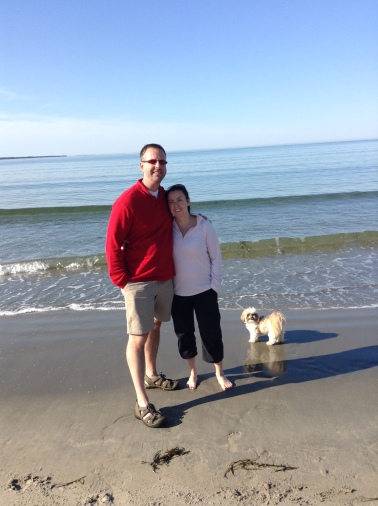It’s National Dog Day and being a dog owner, how could I possibly let the day go without a post? It would not seem right.
Over the last month or so, I’ve had the opportunity to think quite intensely about the role of pets in people’s lives. On July 11th, my sister said goodbye to the family dog of 12 years, Monty. Many days since that goodbye, she and her family have been sharing Monty stories and reliving the joy that he brought to their lives. Of course dogs are work and sometimes an inconvenience, but they also can enhance even the simplest of leisure experiences such as watching a movie (can’t pass up those dog snuggles) and walking in your neighbourhood. They can encourage leisure behaviour such as playing with pets or getting out to walk your dog if you’re not someone who normally walks. Dogs can also help create fabulous memories on vacation (like the time Monty stepped off the wharf thinking the green algae was grass – thankfully, he had on a doggie life jacket). As I think about Monty and other dogs (including my own dog, Chuckie) who have enhanced my life and the lives of friends, I wanted to take some time to share the research on dogs and leisure.
Despite the rise in dog ownership over the last 30 years in North America, there is not an overwhelming amount of research on the topic of dogs and leisure. What does exist in terms of research suggests that there are considerable mental and physical health benefits to having a dog and that dogs do create and enhance the leisure experiences of their owners. This is likely not a surprise to dog owners.
Happiness and Dogs
Research has found that having a dog can reduce feelings of loneliness and isolation and increase an individual’s sense of security and happiness (Sable, 1995). Dogs can provide companionship throughout the life cycle – for single adults, empty nesters, and children without siblings (Anderson, 2008; Hodgson & Darling, 2011). The interaction children have while caring for and playing with their dog can increase children’s attachment and in turn, their psychological health (Salmon & Timperio, 2011). Through leisure, children and adults can let go of pent up frustrations and stress emotions and playing with dogs is one particular leisure activity that allows for this opportunity. Although there is a lack of academic research on it, I have been more aware recently of dogs being calming companions for individuals who suffer from Post-Traumatic Stress Disorder (PTSD).
Dogs Promote Social Contact
Dogs encourage owners to engage in outdoor recreation and interact with others in the broader community (Wood, Giles-Corti, & Bulsara, 2005; Wood, Giles-Corti, Bulsara, & Bosch, 2007). Graham and Glover (2014) describe dogs as “social facilitators” indicating a dog’s role in fostering opportunities for social leisure and engagement. Beck and Meyers (1996) found that dog owners had more and longer conversations while walking their dogs than people walking alone.
An interesting study by Graham and Glover (2014) focused on dog parks. They found that initially, human dog park visitors only knew other human visitors by their dogs’ names. Study participants discussed that how their dog interacted with other dogs and with the other humans in the dog park influenced the way they, as dog owners, were welcomed and/or treated and how they welcomed and developed relationships in turn. As time passed, some dog owners arranged to meet at the park at certain times so they and their dogs could interact. Some dog owners also eventually developed relationships that extended outside of the dog park. The study also provides examples of social support being accessed by dog owners when they were facing a difficult time (e.g., sick dog, sick child). Visiting dog parks provided opportunities for those with similar interests (i.e., dogs) to come together, to meet, and develop relationships that provided to be valuable, beneficial, and supportive.
Dogs and Physical Activity
It appears that having a dog can be good for your physical activity levels and has even been proposed as a solution to obesity (Boisvert & Harrell, 2014; Salmon, Timperio, Chu, & Veitch, 2010). One Canadian study found that those adults with dogs walk almost twice as much as those who do not have dogs (Brown & Rhodes, 2006). Cutt, Knuiman, and Giles-Corti (2008) found that getting a dog not only increased individuals’ recreational walking, but also their intention to participate in recreational walking. The responsibility to care for a dog (which includes proper exercise) is likely a key motivator in getting dog owners out walking. The researchers also believed that acquiring a dog may be significant in influencing continued walking behaviours over time. Also, they point out that while life transitions (e.g., moving from singlehood to couplehood) can result in decreases in physical activity, dog ownership and the sense of responsibility to exercise the dog, may allow dog owners to maintain physical activity levels during times of transition.
Dogs and Vacations
We enjoying taking our shih tzu, Chuckie, on vacation. Recently, I went to Prince Edward Island with a friend and for the first time, left Chuckie at home with my husband. It was strange. The routine of taking him for a walk in the morning was missing. We even missed rushing back from our various adventures on the Island to hang out with him. And, we missed taking him for a car ride in the evenings when we went to watch the sunset. When we visit my mother in Nova Scotia, Chuckie loves going to the beach and it brings us great joy to watch him enjoy that part of our vacation as much as we do.
There is research on pets and travel. One Australian study found approximately 95% of dog owners preferred to take their dogs on vacation (Carr & Cohen, 2009). Another US-based study found that 78% of dog owners preferred to take their dogs on vacation (Hotel Online, 2003). Carr and Cohen also found that dog owners wanted to bring their dogs on vacation because it add to the “pleasure, enjoyment, and relaxation gained by them from the vacation experience” (p. 294). While the desire to take pets on vacation is quite high, pet owners also identify constraints in doing so – mainly a lack of pet-friendly accommodations. This can mean that travellers may choose (or be forced) to camp, stay with friends who welcome dog visitors, or book more expensive accommodations (e.g., cottages) as part of their vacation plans.
When dogs cannot accompany families on vacation, this increases the vacation planning as owners need to work out suitable arrangements for their dog and may also experience anxiety about how their pet is doing in their absence (or maybe that’s just me). In my own case, I find myself planning my vacation in a way that can include our dog and so my attachment to him influences the types of vacation experiences I seek.
I wish all dog owners a happy National Dog day. For those who recently lost a dog, I hope that the day is a chance to focus on the joy your dog brought and perhaps is an opportunity to anticipate the joy that a dog will bring to your life in the future.
References:
Anderson, P. E. (2008). The powerful bond between people and pets: Our boundless connections to companion animals. Westport, CT: Praeger.
Beck, A. M., & Meyers, M. (1996). Health enhancement and companion animal ownership. Annual Review of Public Health, 17, 247–257.
Boisvert, J. A., & Harrell, W. A. (2014). Dog walking: a leisurely solution to pediatric and adult obesity?. World Leisure Journal, 56(2), 168-171.
Brown, S. G., & Rhodes, R. E. (2006). Relationships among dog ownership and leisure-time walking in Western Canadian adults. American Journal of Preventive Medicine, 30, 131–136.
Cutt, H., Knuiman, M., & Giles-Corti, B. (2008). Does getting a dog increase recreational walking? International Journal of Behavioral Nutrition and Physical Activity, 5(1), 17. Available at: http://www.ijbnpa.org/content/5/1/17
Graham, T. M., & Glover, T. D. (2014). On the Fence: Dog Parks in the (Un) Leashing of Community and Social Capital. Leisure Sciences, 36(3), 217-234.
Hodgson, K., & Darling, M. (2011). Pets in the family: Practical approaches. Journal of the American Animal Hospital Association, 47(5), 299–305.
Hotel Online . ( 2003 ) The Sheraton, Westin, and W Hotel brands drop restrictions for dogs; Starwood survey convinces chain to include market niche of 62 million U.S. dog owners: http://hotel-online.com/archive/archive-7292.
Sable, P. (1995). Pets, attachment, and well-being across the life cycle. Social Work, 40(3), 334–341.
Salmon, J., & Timperio, A. (2011). Childhood obesity and human-animal interaction. In P. McCardle, S. McCune, J. A. Griffin, & V. Maholmes (Eds.), How animals affect us: Examining the influences of human-animal interaction on child development and human health (pp. 183–192). Washington, DC: American Psychological Association.
Salmon, J., Timperio, A., Chu, B., & Veitch, J. (2010). Dog ownership, dog walking and children’s and parent’s physical activity. Research Quarterly for Exercise and Sport, 81, 264–271.
Wood, L., Giles-Corti, B., Bulsara,M., & Bosch, D. (2007).More than a furry companion: The ripple effect of companion animals on neighborhood interactions and sense of community. Society & Animals, 15(1), 43.
Wood, L., Giles-Corti, B., & Bulsara, M. (2005). The pet connection: pets as a conduit for social capital? Social Science and Medicine, 61(6), 1159–1173.
Tagged: dog owners, dogs, leisure, National Dog Day, pet ownership, pets, social leisure, vacation


Excellent article!! If it wasn’t for me being able to walk my dog 4-5 days a week while I was in grad school to clear my head, I would have gone crazy!
LikeLiked by 1 person